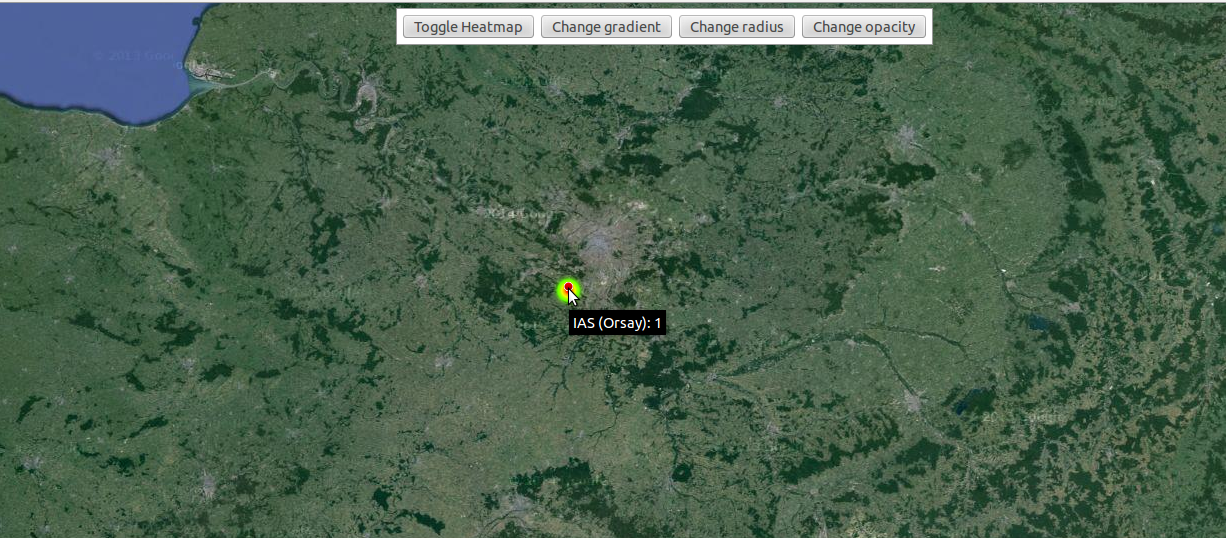Show data on Google Maps¶
The following HTML code uses the Google Maps API to display data as Heatmap + Marker.
Additional information are also provided when the cursor is put on the marker.
<!DOCTYPE html>
<html>
<head>
<meta charset="utf-8">
<title>Heatmaps</title>
<style>
html, body, #map-canvas {
height: 100%;
margin: 0px;
padding: 0px
}
#panel {
position: absolute;
top: 5px;
left: 50%;
margin-left: -180px;
z-index: 5;
background-color: #fff;
padding: 5px;
border: 1px solid #999;
}
</style>
<script src="https://maps.googleapis.com/maps/api/js?v=3.exp&signed_in=true&libraries=visualization&sensor=true"></script>
<script>
// This example creates a heatmap + marker on the map, over the IAS
var map, pointarray, heatmap;
var citymap = {};
citymap['IAS'] = {
title: 'IAS',
center: new google.maps.LatLng(48.698972, 2.174751),
visits: 1,
city: 'Orsay',
country: 'France'
};
// Create the heatmap gradient with five points
var ipData = [
new google.maps.LatLng(48.698972, 2.174751),
new google.maps.LatLng(48.698972, 2.174751),
new google.maps.LatLng(48.698972, 2.174751),
new google.maps.LatLng(48.698972, 2.174751),
new google.maps.LatLng(48.698972, 2.174751),
];
function initialize() {
// Centering and type of shown map
var mapOptions = {
zoom: 7,
center: new google.maps.LatLng(48.698972, 2.174751),
mapTypeId: google.maps.MapTypeId.SATELLITE //TERRAIN
};
map = new google.maps.Map(document.getElementById('map-canvas'),
mapOptions);
// Construct the marker for each value in citymap (just one, in this case).
for (var city in citymap) {
var contentString = citymap[city].title+' ('+citymap[city].city+')'+': '+citymap[city].visits;
var populationOptions = {
map: map,
position: citymap[city].center,
title: contentString,
icon: 'http://szcluster-db.ias.u-psud.fr/sitools/upload/locMarker_redCircle.gif',
};
// Add the circle for this city to the map.
cityCircle = new google.maps.Marker(populationOptions); //Marker
}
var pointArray = new google.maps.MVCArray(ipData);
heatmap = new google.maps.visualization.HeatmapLayer({
data: pointArray,
dissipating: 1,
opacity: 1,
maxIntensity:5,
radius: 15
});
heatmap.setMap(map);
}
function toggleHeatmap() {
heatmap.setMap(heatmap.getMap() ? null : map);
}
function changeGradient() {
var gradient = [
'rgba(0, 255, 255, 0)',
'rgba(0, 255, 255, 1)',
'rgba(0, 191, 255, 1)',
'rgba(0, 127, 255, 1)',
// 'rgba(0, 63, 255, 1)',
// 'rgba(0, 0, 255, 1)',
// 'rgba(0, 0, 223, 1)',
// 'rgba(0, 0, 191, 1)',
// 'rgba(0, 0, 159, 1)',
// 'rgba(0, 0, 127, 1)',
// 'rgba(63, 0, 91, 1)',
// 'rgba(127, 0, 63, 1)',
'rgba(191, 0, 31, 1)',
// 'rgba(255, 0, 0, 1)'
]
heatmap.set('gradient', heatmap.get('gradient') ? null : gradient);
}
function changeRadius() {
heatmap.set('radius', heatmap.get('radius') ? null : 10);
}
function changeOpacity() {
heatmap.set('opacity', heatmap.get('opacity') ? 0.8 : 1);
}
google.maps.event.addDomListener(window, 'load', initialize);
</script>
</head>
<body>
<div id="panel">
<button onclick="toggleHeatmap()">Toggle Heatmap</button>
<button onclick="changeGradient()">Change gradient</button>
<button onclick="changeRadius()">Change radius</button>
<button onclick="changeOpacity()">Change opacity</button>
</div>
<div id="map-canvas"></div>
</body>
</html>
The browser will display the HTML in this way:
